When DIY moving antiques (which are very frequently quite irreplaceable), extra care has to be taken to ensure that they cannot be damaged in any way during their relocation. So it’s extremely important that your movers know exactly how to move an antique. If they don’t know the best way to move an antique, costly and extremely upsetting damages are sure to occur.
Notice the size and quality of exquisite antiques. Such a piece should only be moved by highly-experienced movers, not by amateurs trying to do DIY antique moving.
But if circumstances are such that inexperienced people must be used to move antiques like this, you would want to have at least 4 or 5 people handling it. They would need to pad it up really well to protect it and then
move it slowly and carefully just a little at a time.

Any damages whatsoever can diminish the value of an antique, even though the antique piece may be perfectly repaired after the damage.
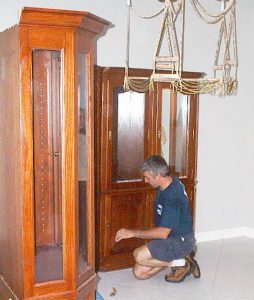
When moving antiques, use the extra protection of bubble wrap, thin foam wrap (called dolphin foam), cardboard, shrink wrap and/or extra mover’s blankets whenever possible as is shown below.
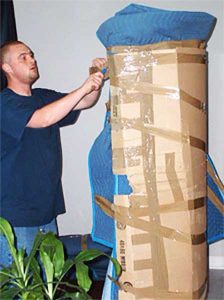
How to pack antique furniture
To most people, the easiest way to handle any furniture piece, especially an antique piece, seems to be when it’s not padded because they think then it’s easiest to be gripped. But it’s easier to carry a furniture piece when its padding is tightly taped to it because you can grip the pads when carrying the piece. When it’s being carried unpadded, it’s very susceptible to unwanted scratches, rubs, bruises, gouges, etc. So we highly recommend that all furniture pieces, especially antique pieces, be thoroughly and securely tape padded and/or covered with some or all of the above-mentioned materials.
Padding on antique furniture pieces should start with bottom pads in order to protect all bottom edges. Then drape the pads down from the top of the piece and secure them with tape to the lifted sides of the bottom pad(s). For an example of this kind of padding, go to Armoires.
Padding on furniture pieces with legs should start with top padding and then more pads should be draped down beyond the bottom in order to leave enough padding to be taped around the legs. For an example of this kind of padding, go to China Cabinets.
The secret to getting a good grip on a covered piece when carrying it is to be very sure that all the pads are tightly and carefully secured with enough tape so that they won’t break loose like has been done to the big furniture piece in the picture below.
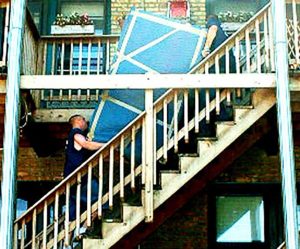
When preparing antiques with any of these various protective coverings, use mover’s plastic tape to secure the covering. Always be very careful not to allow the sticky side of the tape to touch the finish of the piece.
The stickum should only touch the pads or the other tape windings already over the pads so as to not leave tape residue upon the finish.
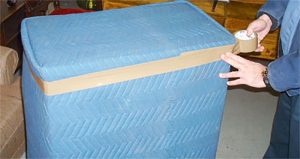
Neatly and fully pad each piece as is being done in the above picture so that there is a minimal chance of scratching or bruising it when it is carried.
Remember, it’s better to be safe than sorry – so really pad it and tape it up well!
Notice the extent of the padding and cardboarding on the large antique armoire pictured below which is about to be hoisted through an upstairs bedroom window. This extra care is needed because it will have to be slid into the upstairs room through the window and it will be scraped in the process. Notice on the armoire’s right side the extra cardboard and excess top padding needed for the slide.
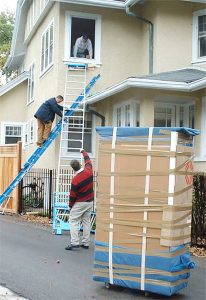
Some antiques are just too delicate to be heavily padded like this one.
In that case, just pad what you can and then be very, very careful when moving them!
Some antiques will have small wooden casters that can easily break or come off and be lost. If possible, remove the casters and save them until the antique piece has been brought to its new location and then put them back on. Otherwise, wrap paper or foam wrap around each caster and tape it to the padding that extends down to its leg so that it doesn’t fall off and get lost during the move. If you prefer, pad up small pieces with casters just as we teach you to do for a chair with casters. If a piece has claw feet, you can also do the same to them.
How to move antique furniture
Some casters and claw feet are irreplaceable so be extremely careful not to break or lose them!
After padding them, carry or dolly these pieces upside down so as not to accidentally damage their casters or claw feet.
Never push or pull an antique on its pads because antiques are delicate from age and some part of the piece could then get broken inside of the pads. Always carefully carry or dolly your antiques. Never slide them around. Casters and claw feet can break when slid around, even inside of pads!
Some antiques have glass in their doors or adorning them in some fashion. In this case, after padding the piece, cut some cardboard and tape it securely over the place on the pads where the glass is right underneath as shown below and in various other pictures on this page.
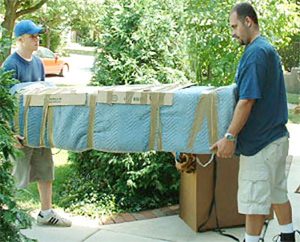
In some cases, you might even put bubble wrap under the cardboard first, for extra, extra protection. Also, some antiques have carvings all over them that can be chipped or knocked loose so in that case, wrap the whole piece with bubble wrap, then pads, then cardboard. Then have the same movers that pad it always be the only ones to carry or dolly it because they will be most familiar with what is under the pads.
Sometimes the legs of a smaller antique piece are just too weak to endure the bounce pressures of a truck ride. In that case, it has to be transported upside down on top of the load to cushion it. But then some of these small antique pieces can have a crown that juts above the flat top surface of the piece. Here, double padding has to be built up inside the crown, much higher than the crown so that when it’s set upside down, it will keep the crown from breaking on another piece as the pads compress.
Whenever it makes the most sense to take a piece apart, carefully mark each piece for reassembly later. Also, carefully save the hardware since it’s always irreplaceable. Wrap the hardware in a piece of paper and secure it inside the paper by covering it with tape and then tape the bundle to the inside or bottom of the piece. Or save the hardware in a small zip-lock bag and put it in a safe place, like your car’s glove compartment.
In many cases, however, disassembly is not feasible because old bolts might be stripped or it’s just too delicate. Then, be very, very careful when you are moving it because the nature of all antique pieces is that they are fragile from their age.
It’s important to understand that packing and moving antique furniture is a job for experienced movers who will take the utmost care when handling your valuable furniture pieces. Get a free quote to see who much top-rated furniture movers will charge you for the job simply because the risks of moving antique furniture by yourself is too risky.


